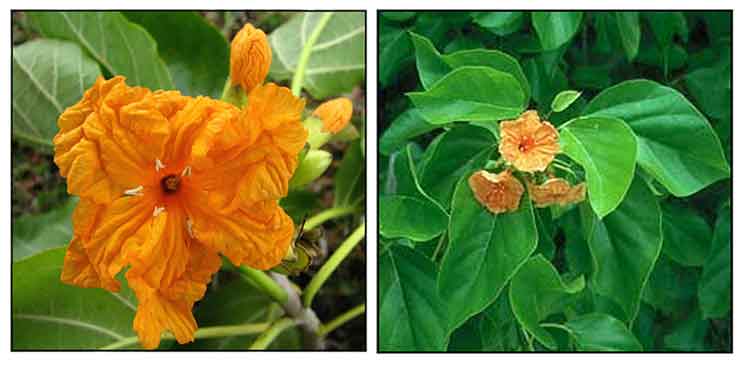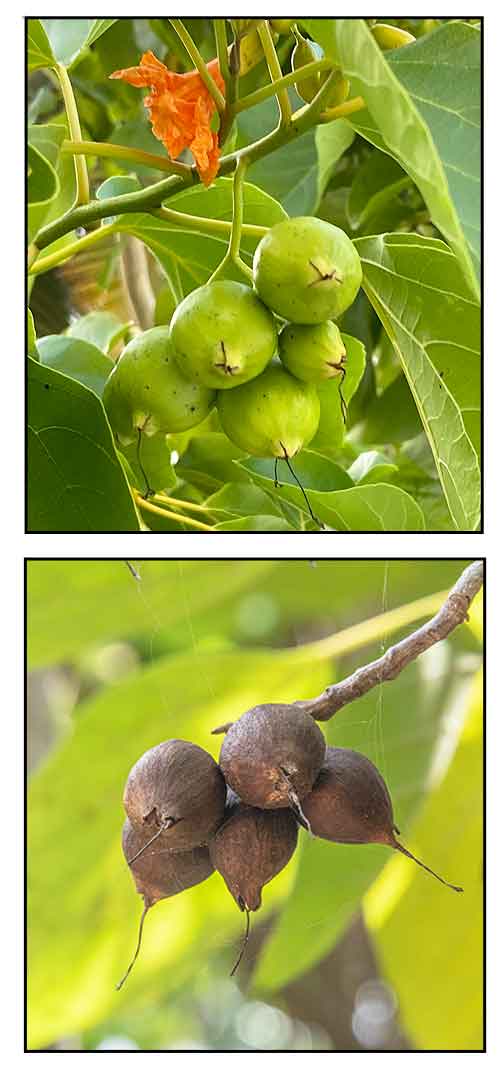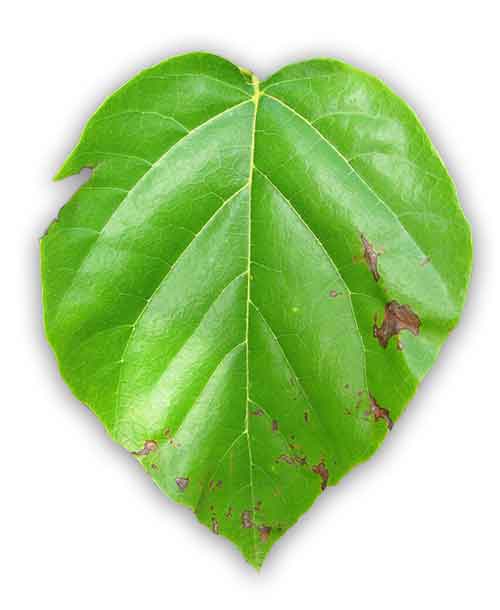 Gen info Gen info
- Cordia is a genus of flowering plants in the borage family, Boraginaceae, comprising more than 300 species of shrubs and trees.
- Etymology: The genus name Cordia honors Valerius Cordus (1514-1544), a German botanist and pharmacist, considered one of the fathers of pharmacognostics. The species epithet subcordata means "somewhat heart-shaped", referring to the leaves. (4)
Botany
• C. subcordata or kou trees grows to 7–10 m (23–33 ft) at maturity, but may be as tall as 15 m (49 ft). Leaves are ovate leaves, 8–20 cm (3.1–7.9 in) and 5–13 cm (2.0–5.1 in) wide with short hairs on the upper surface. Flowers are funnel- or tube-shaped, 1–2 cm (0.39–0.79 in) long and 0.4–0.8 cm (0.16–0.31 in) in diameter, with orange petals and pale green sepals that form cymes or panicles. Fruits are spherical 2–3 cm (0.79–1.18 in) long, brown, and woody when mature. Each fruit contains four or fewer seeds, 10–13 mm (0.39–0.51 in) long. Fruits are buoyant, carried far by ocean currents. (2)
• Growth form: A small, evergreen, bushy tree up to 20 m tall. Trunk: Trunk sometimes crooked, girth size is 40 cm wide or less, bark is pale grey and furrowed. Foliage: Light green broadly elliptic to ovate leaves, alternate arrangement, measuring about 8 - 20 cm long and 5 - 15 cm wide, petiole about 5 cm long. Flowers: Orange funnel-shaped flowers borne on axillary and terminal cymose inflorescence, each flower about 2.5 - 4 cm long and has 5 - 7 wrinkly and rounded lobes, peduncle about 0.5 - 2 cm long, pedicels about 2 - 10 mm. Fruit: Fruit is a brown, round and woody nut about 1.5 - 3 cm long, contains 4 or less white seeds. (4)
 Distribution
Distribution
- Native to the Philippines.
- Common in forests and thickets along the seashore.
- Also native to Aldabra, Andaman Is., Bangladesh, Bismarck Archipelago, Borneo, Cambodia, Caroline Is., Chagos Archipelago, Christmas I., Cocos (Keeling) Is., Comoros, Cook Is., Fiji, Gilbert Is., Hainan, Hawaii, Howland-Baker Is., India, Jawa, Kenya, Laccadive Is., Lesser Sunda Is., Line Is., Madagascar, Malaya, Maldives, Maluku, Marianas, Marquesas, Marshall Is., Mozambique, Mozambique Channel Is., Myanmar, Nauru, New Caledonia, New Guinea, Nicobar Is., Niue, Northern Territory, Phoenix Is., Pitcairn Is., Queensland, Samoa, Seychelles, Society Is., Solomon Is., Somalia, South China Sea, Sri Lanka, Sulawesi, Tanzania, Thailand, Tokelau-Manihiki, Tonga, Tuamotu, Tubuai Is., Tuvalu, Vanuatu, Vietnam, Wake I., Wallis-Futuna Is., Western Australia. (1)
- Endangered in some places due to logging of mature trees and use for carvings for tourism commerce.
Constituents
- Preliminary phytochemical screening of ethanolic, extract of Cordia subcordata leaves yielded alkaloids, flavonoids, carbohydrates, glycoside, tannins, terpenoids, with absence of saponins and steroids. (see study below) (5)
Properties
- Kou's susceptibility to the kou leaf worm (Ethmia nigroapicella) has forced many horticulturists and ornamental growers in Hawai'i to replace it with non-native Geiger tree (Cordia sebestena). (6)
- Seeds float and are highly resistant to salt water, and are therefore common in coastal areas. (7)
-
Studies have suggest antioxidant, hepatoprotective , anti-asthmatic , memory enhancing properties.
Parts used
Leaves.
Uses
Edibility
- Seeds are edible; eaten during times of famine. (2)
- In Polynesia, young leaves used as masticatory with betel leaves.
- Fruit is edible.
Folkloric
- No reported folkloric medicinal use in the Philippines.
- In Tahiti, leaves used for treatment of bronchitis and asthma; also as purgative. Plant used for treatment of hepatic infections, cirrhosis of the liver, and inflammation of the lymph nodes. Also used for treatment of albumin in the urine.
Cook Islanders used the leaves for treatment of abdominal swellings and urinary tract infections. (7)
- In Indonesia, young leaves, crushed or rubbed on the hands impart an odor which protects from stings of poison fish; if stung, the leaves are rubbed on the wounds to subdue the pain. In New Guinea, decoction of leaves are used to bathe limbs of people with muscular or rheumatic pains. In East New Britain, fresh leaves are applied externally for tropical ulcers and knee wounds. (11)
 Others Others
- Wood: Timber is beautifully grained, soft, durable, glossy, easily worked on, and resistant to termites. Heartwood is pale to dark brown, often with a purplish tinge and dark brown to black streaks. Used for light construction, beams and posts, cabinets, furniture, musical instruments, scabbards, tools, carving; also for veneer. (3) Use for making canoes or paddles if large enough trees are found. In Papua New Guinea, the wood is prized traditional artisans using it for handicrafts and carving of traditional figures.
(6)
- Fuel: Wood burns easily as firewood, which led to the name "kerosene tree" in Papua New Guinea. (2)
- Decorative: Attractive orange flowers are used for making lei.
- Dye: Leaves yield a dye used for kapa cloth and aho (fishing lines).
- Crafts: Bark yields a fiber. Fijians use the fiber from the inner bark after soaking it in seawater for weaving and making baskets and garlands. In the Solomon Islands, Vanuatu, Waya Island, and Tonga, wood used for carving. In ancient Hawaii, used for making 'imeke' (bowls), utensils, and 'umeke la-au' (large calabashes). (2) Wood used for carving figures and making war weapons. Cordia subcordata provides the finest wood on the Tokelau Islands, north of Samoa, where the plant is known as kanava, and used to make plank canoes, drums, and cooking utensils. (8)
- Fodder: Kou leaves used as fodder for pigs in Kiribati and elsewhere. (6)
- Rituals: In New Ireland, wood used for ceremonial entrances in men's houses. Plant is planted along sacred places. Wood used for carving figures. (•) In the Pacific, the tree is significant culturally and in traditional religions. Kou figures in Pacific island mythology. Groves are planted around sacred places. (6)
- Masticatory: In Polynesia, young leaves sometimes chewed together with betel nut.
- Agroforestry: Tree planted as a windbreak and living fence. Also used for conservation of eroding coastal areas. (3) (6)
Studies
• Antioxidant / Erythrocyte Protective Activity / Acute Toxicity Study / Leaves: Study evaluated the antioxidant activity of ethanol extract of Cordia subcordata in rats with carbon tetrachloride (CCl4) induced erythrocyte damage in male albino rats.. Simultaneous administration of EECS (200 and 400 mg/kbw i.p.) to rats on alternate days for two weeks protected the loss of functional integrity and membrane lipid alteration in RBCs induced by oxidative stress. EECS inhibited accumulation of lipid peroxidation products in the plasma and maintained activities of antioxidant enzymes such as superoxide dismutase (SOD) and catalase. EECS had ability to decrease membrane fluidity induced by CCl4. Acute toxicity study of 90% ethanolic extract using OECD guidelines showed no mortality even at 2000 mg/kg dose. Results suggest erythrocyte protective activity against drug induced oxidative stress. (5)
• Hepatoprotective Against CCl4-Hepatotoxicity / Leaves: Study evaluated the liver protective effect of ethanol extract of C. subcordata leaves on carbon tetrachloride induced hepatocyte in Wistar albino rats. The extract administered at doses of 100, 200, and 400 mg/kg p.o. for 3 days resulted in significant decreases in CCl4-induced elevation of hepatic enzymes SGOT, SGPT, AP, and acid phosphatase in a dose dependent manner. Results indicate production of structural integrity of hepatocytic cell membrane or regeneration of damaged cells by the extracts. (7)
• Anti-Asthmatic / Leaves: Study evaluated the effect of ethanol extract of Cordia subcordata bark at doses of 25, 50, and 100 mg/kg on isolated goat tracheal chain preparation, passive paw anaphylaxis in rat. The extract showed significant dose-dependent anti-asthmatic activity in all models. (9)
• Memory Enhancing Effect: Study evaluated the the effects of methanolic extract of Cordia subcordata on learning and memory in albino mice. Doses of 200 and 400 mg/kg p.o. of methanol extract were administered for neurotoxicity test. Passive shock avoidance paradigm and Morris water maze test were employed to test learning and memory. Corticosterone (5 mg/kg) significantly induced amnesia in elevate plus maze as indicated by increase inflexion ration and reduction in transfer latency. In the Morris water maze test, C. subcordata improved impairment of spatial memory induced by corticosterone as indicated by formation of reference and working memories. Possibly, the beneficial effects on learning and memory were due to facilitation of cholinergic-transmission in mouse brain. (10)
Availability
- Wild-crafted.
- Seeds in the cybermarket.
|

![]()



 Gen info
Gen info Distribution
Distribution
